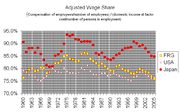
Wage share
Encyclopedia

Wage
A wage is a compensation, usually financial, received by workers in exchange for their labor.Compensation in terms of wages is given to workers and compensation in terms of salary is given to employees...
share is the ratio between compensation of employees
Compensation of employees
Compensation of employees is a statistical term used in national accounts, balance of payments statistics and sometimes in corporate accounts as well...
(according to the system of National accounts
National accounts
National accounts or national account systems are the implementation of complete and consistent accounting techniques for measuring the economic activity of a nation. These include detailed underlying measures that rely on double-entry accounting...
) and one of the following variables:
- gross domestic productGross domestic productGross domestic product refers to the market value of all final goods and services produced within a country in a given period. GDP per capita is often considered an indicator of a country's standard of living....
at market prices - gross domestic product at factor cost.
- net domestic productNet domestic productThe net domestic product equals the gross domestic product minus depreciation on a country's capital goods.Net domestic product accounts for capital that has been consumed over the year in the form of housing, vehicle, or machinery deterioration...
at factor cost (domestic income at factor cost)
An adjustment is often made so that the wage share reflects only changes in relative incomes and not changes in the composition of employment
Employment
Employment is a contract between two parties, one being the employer and the other being the employee. An employee may be defined as:- Employee :...
in employees and number of self-employed. In this case the adjusted wage share is:
compensation of employees per employee
divided by one of the following:
- gross domestic product at market prices per number of persons in employment (this adjusted wage share is also called real unit labour costs).
- gross domestic product at factor cost per number of persons in employment
- net domestic product at factor cost (domestic income at factor cost) per number of persons in employment
The wage share is a (rough) indicator for the distribution of income between capital and labour. In the short term it moves countercyclically
Countercyclical
Countercyclical is a term used in economics to describe how an economic quantity is related to economic fluctuations. It is the opposite of procyclical. However, it has more than one meaning.-Meaning in policy making:...
to the business cycle
Business cycle
The term business cycle refers to economy-wide fluctuations in production or economic activity over several months or years...
.
Criticism
The main criticism of the wage share concept is simply that it does not accurately describe the share-out of income between employers and employees. The reason is that the incomes included in the ratio are those that conform to the concept of value addedValue added
In economics, the difference between the sale price and the production cost of a product is the value added per unit. Summing value added per unit over all units sold is total value added. Total value added is equivalent to Revenue less Outside Purchases...
.
Compensation of employees
Compensation of employees
Compensation of employees is a statistical term used in national accounts, balance of payments statistics and sometimes in corporate accounts as well...
is not the same as the disposable real income that workers get, and Operating surplus
Operating surplus
Operating surplus is an accounting concept used in national accounts statistics Operating surplus is an accounting concept used in national accounts statistics Operating surplus is an accounting concept used in national accounts statistics (such as United Nations System of National Accounts (UNSNA)...
is not the same as real profits realised by enterprises. Consumption of fixed capital
Consumption of fixed capital
Consumption of fixed capital is a term used in business accounts, tax assessments and national accounts for depreciation of fixed assets...
, another component of GDP, is measured at economic depreciation rates, which may diverge from real income obtained from depreciation write-offs.
Finally, the indirect taxes net of subsidies included in GDP are only those regarded as direct imposts on production. In summary, GDP only very selectively measures total income flows - disregarding transfer income, property income and capital gains, land rents, subsoil rents and a fraction of net interest. As a result, the value of the share of wages in the product may be overstated, particularly if taxes on consumption increase as well.
See also
- Cost the limit of priceCost the limit of priceCost the limit of price was a maxim coined by Josiah Warren, indicating a version of the labor theory of value. Warren maintained that the just compensation for labor could only be an equivalent amount of labor . Thus, profit, rent, and interest were considered unjust economic arrangements...
- Labour
- Rate of exploitation
- Value addedValue addedIn economics, the difference between the sale price and the production cost of a product is the value added per unit. Summing value added per unit over all units sold is total value added. Total value added is equivalent to Revenue less Outside Purchases...
- Value productValue productThe value product is an economic concept formulated by Karl Marx in his critique of political economy during the 1860s, and used in Marxian social accounting theory for capitalist economies...
- WageWageA wage is a compensation, usually financial, received by workers in exchange for their labor.Compensation in terms of wages is given to workers and compensation in terms of salary is given to employees...

